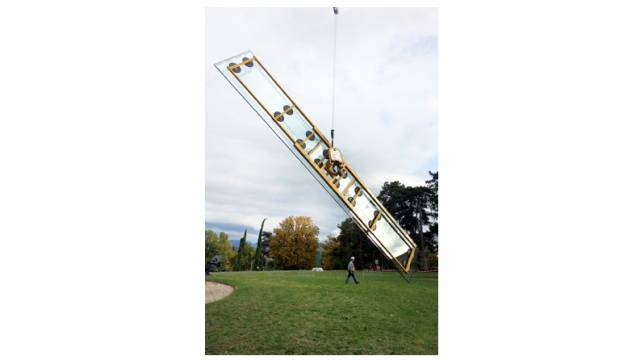The 13m-high glass being transported to its position
sedak delivered the impressive 13m-high tempered double IGUs produced fully automatically and packed in specially fabricated boxes adjusted to the dimensions of the formats and corresponding to safety requirements.
The renovation of the UNO building “United Nations Conference on Trade and Development” in Geneva shows how today’s production technology makes monumental protection possible also for buildings with glass façades. The 13m-high insulating glass units, which in 1971 had been fabricated manually and during an effortful process, had now to be replaced. sedak delivered tempered double IGUs produced fully automatically. The dimensions are still impressive.
It was a spectacular exchange: In 2016, parts of the glass façade of the UNO building “United Nations Conference on Trade and Development” in Geneva (second headquarters of the United Nations) were replaced. The about 45-year-old glazing had become foggy; some of the glass units had cracked; the bonding of the support structure of the glass façade had aged. Due to monumental protection, the new glass units had to be true to the original, i.e. of the same oversize dimensions. Additionally, the special supporting structure of the building was supposed to be maintained.
The dimensions of the glass units were exceptional for the year 1971. They were manufactured manually out of non-tempered glass and were said to be perhaps the largest units that had been produced by then. Today, sedak provides tempered insulating glass up to 15m manufactured fully automatically.
“To be able to install the glass in 1971, the building envelope was realized as a hanging façade. That principle had to be kept in mind,“ says Ralf Scheurer, who was the sedak responsible for the project. It took the metal constructors (Metallover SA, Carouge/ Switzerland) about four months to check whether the project is possible at all.
Also the colour had to fulfill specific requirements: For the UNO building, it was only allowed to use standard float glass (green glass) which cannot be procured as fast as low-iron glass. “We were able to offset the longer delivery time of the raw material with the quick production at sedak,” says Scheurer. The insulating glass units had been manufactured within just a few weeks.
sedak produced a total of nine double IGUs out of 12mm thick basic glass (dimensions: three units in 2.29m x 7.84m, six units in 2.29m x 13.10m). The single glass panes had been produced as heat-strengthened safety glass to guarantee a higher break resistance.
The metal blocks of the old façade were replaced by glass blocks that were attached to the IGUs with a special adhesive. “Before replacing the metal blocks, the contracted metal engineering company had run special material test series in Lausanne. In the end, glass turned out to be the best material for the bonding. That shows once again how versatile glass is,” explains Scheurer.
sedak packed the insulating glass units in specially fabricated boxes which were adjusted to the dimensions of the formats and corresponded to the safety requirements with a supporting structure.
A low-bed trailer transported the glass units to Geneva where they were installed with a truck crane and a glass vacuum lifter. In September 2016, the installation was completed.




